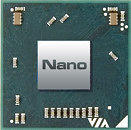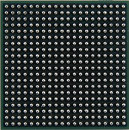Thursday, May 29th 2008

VIA Launches VIA Nano Processor Family
VIA Technologies, Inc, a leading innovator of power efficient x86 processor platforms, today announced the new VIA Nano processor family based on the VIA Isaiah Architecture. Building on the market-leading energy efficiency of the VIA C7 processor family, the VIA Nano processor family offers as much as four times the performance within the same power range to extend VIA's performance per watt leadership, while pin compatibility with VIA C7 processors will ensure a smooth transition for OEMs and motherboard vendors, and provides them with an easy upgrade path for current system or board designs.The first 64-bit, superscalar, speculative out-of-order processors in VIA's x86 platform portfolio, VIA Nano processors have been specifically designed to revitalize traditional desktop and notebook PC markets, delivering truly optimized performance for the most demanding computing, entertainment and connectivity applications, including Blu-ray Disc HD video playback and the latest PC games, such as Crysis.
The VIA Nano processor family leverages Fujitsu's advanced 65 nanometer process technology for enhanced power efficiency, and augments that with aggressive power and thermal management features within the compact 21mm x 21mm nanoBGA2 package for an idle power as low as 100mW (0.1W), extending the reach of power efficient green and silent PCs, thin and light notebooks and mini-notes around the world.
"VIA Nano processors represent the next generation of x86 technology, providing the fundamental building blocks for a new genre of optimized computing solutions," said Wenchi Chen, President and CEO, VIA Technologies, Inc. "'Small is Beautiful' is more than a design strategy; it's our vision of where the PC market is heading and our new processors will help the market realize that dream."
VIA's 'nano' association also extends to VIA's signature silicon and platform design characteristics of power efficiency and form factor size reduction, as demonstrated by VIA's ultra compact Nano-ITX boards and the nanoBGA2 processor packaging used for the current VIA C7 processor family and the first generation of VIA Nano processors.
About the VIA Nano Processor Family
Initially to be launched in two skus, the VIA Nano L-series processors for mainstream desktop and mobile PC systems and the ultra low voltage U-series for small form factor desktop and ultra mobile devices such as mini-notes:

The VIA Nano processor family boasts the highly efficient VIA V4 bus interface and brings a host of technology firsts to VIA's processor platform line-up, including:
VIA Nano processors are available now for OEMs and motherboard vendors, while systems featuring VIA Nano processors are expected to market in Q3 2008.
Source:
VIA
The VIA Nano processor family leverages Fujitsu's advanced 65 nanometer process technology for enhanced power efficiency, and augments that with aggressive power and thermal management features within the compact 21mm x 21mm nanoBGA2 package for an idle power as low as 100mW (0.1W), extending the reach of power efficient green and silent PCs, thin and light notebooks and mini-notes around the world.
"VIA Nano processors represent the next generation of x86 technology, providing the fundamental building blocks for a new genre of optimized computing solutions," said Wenchi Chen, President and CEO, VIA Technologies, Inc. "'Small is Beautiful' is more than a design strategy; it's our vision of where the PC market is heading and our new processors will help the market realize that dream."
VIA's 'nano' association also extends to VIA's signature silicon and platform design characteristics of power efficiency and form factor size reduction, as demonstrated by VIA's ultra compact Nano-ITX boards and the nanoBGA2 processor packaging used for the current VIA C7 processor family and the first generation of VIA Nano processors.
About the VIA Nano Processor Family
Initially to be launched in two skus, the VIA Nano L-series processors for mainstream desktop and mobile PC systems and the ultra low voltage U-series for small form factor desktop and ultra mobile devices such as mini-notes:

The VIA Nano processor family boasts the highly efficient VIA V4 bus interface and brings a host of technology firsts to VIA's processor platform line-up, including:
- 64-bit Superscalar Speculative Out-Of-Order MicroArchitecture: Supports a full 64-bit instruction set and provides for macro-fusion and micro-fusion functionality, and sophisticated branch prediction for greater processor efficiency and performance.
- High-Performance Computation and Media Processing: The high-speed, low power VIA V4 Front Side Bus starting at 800MHz, plus a high floating point unit, support for new SSE instructions, and two 64KB L1 caches and 1MB exclusive L2 cache with 16-way associativity gives a big boost to multimedia performance.
- Advanced Power and Thermal Management: Aggressive management of active power includes support for the new "C6" power state, Adaptive PowerSaver Technology, new circuit techniques and mechanisms for managing the die temperature, reducing power draw and improving thermal management.
- Scalable Upgrade to VIA C7 Processor: Pin-to-pin compatibility with current VIA C7 processors enables a smooth transition for OEMs and mainboard vendors, enabling them to offer a wider range of products for different markets with a single board or system design.
- Greener Technology: In addition to full compliance with RoHS and WEEE regulations, product manufacturing will be halogen-free and lead-free at launch, helping to promote a cleaner environment and more sustainable computing.
- Enhanced VIA PadLock Security Engine: Industry-leading on-die hardware cryptographic acceleration and security features, including dual quantum random number generators, an AES Encryption Engine, NX-bit, and SHA-1 and SHA-256 hashing.
VIA Nano processors are available now for OEMs and motherboard vendors, while systems featuring VIA Nano processors are expected to market in Q3 2008.


29 Comments on VIA Launches VIA Nano Processor Family
To be honest i doubt these can run crysis like the first paragraph states, however.
BTW those power ratings (above 1.3Ghz) are seriously HIGH. No more passive cooling for VIA. The processor is not scaling well. Something wrong with the design. Too much power leakage at high frequencies. Odd.
as to finding atx, you can if you look hard find matx boards with the c7 and im sure the nano will hit them as well.
as to scaling, i would guess that will get better as they refine making the chips, just as amd and intel chips get better as they mature.
and yes, this chip should be capable of playing crysis at low or medium as well as any low range amd or singel core intel chip, by reports its close to the same effincy per clock as intels chips.....cant wait to see some good reviews of these (hope wizzard can test one)
also likely to see them hit other everex products, i know 2 ppl who have cloudbook's and they LOVE them, both are the c7 version....
the 1.6 is still pretty good, as long as it handles HD media it will definately find a home in many a HTPC.
i wonder if they can handle HD media
as to the audio decoder, coreaac works better then ffdshow aac(lower cpu use, better quility)
a 4-8-16mb videoram arent enought, you need a 32mb card or better, the via onboard SHOULD be fine since they have been reviewed to have decent video acceleration.
P3 1GHz laptop, DX6 capable video card with 16MB ram. I can make them play with coreAVC, audio is fine but the video lags like hell (2-5FPS)
Advise me on how to make it faster :D
ALso :nutkick: to us for going offtopic.
Current C7 1Ghz cpu's are cooled passively and are rated at 5W. Since the Nano U2300 is also rated at 5W, I don't see no reason why this can't be cooled passively.
You can expect the U2300 to be faster than an Atom 1.6Ghz cpu.
also is it the latist coreavc pro?
if not also try ffdshow's current version, free-codecs.com is easyist place to get the up to date version.
I want to see more large busineses that only do word processing use these - the reduction of heat means a reduction on air conditioning, which means very larger overall power savings. (i'm slowly going green, cant help it.)
Silverthorne - MID's only - 13mm x 14mm package - single chip Paulsbo chipset
Diamondville - mini-ITX & Notebooks (4W at 1.6Ghz) - 22mm x 22mm package - 945GC Chipset (20W)
Via Nano - Flexible design chose - 21mm x 21mm package - single chip VX800 (5W)
If you would compare platforms:
L2200 + VX800 = 22W total max
N230 + 945GC + ICH7 = 24W total max
<b>Updated: VX800U uses only 3.5W but it's slower!</b>
Via also allows much more flexibility in the design (no restrictions).
At present, Intel states that manufacturers cannot use its Atom processors in portable systems with a screen size of over 10 inches. Intel hopes that such a restriction will prevent Atom from infringing on its Core 2 mobile market.
Intel also only allows Atom processors to be used with mini-ITX motherboards which feature no PCI Express expansion slots and include only a single DIMM slot.
Even my platform comparison isn't fair since a L2200 will be much faster than a N230.
An U2400 (1.3Ghz) will be fast enough and that one is rated 8W (13W for platform).
You should keep in mind that Diamondville has Hyperthreading and because of that, it's result in synthetic SMT-aware benchmarks (like CrystalMark) are inflated. Real life performance will be lower because in real life Hyperthreading is less efficient.
I guess my next build, will be a pure media system with native HDMI... hehe. and i will definately be looking at these via's as a base - that chart showed isaiah, is that the nano? or is the nano even faster again (they mention 4x faster in the press release)